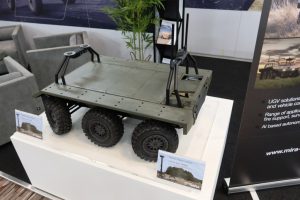
IAV 2023: IDV and Horiba MIRA managers detail the aims of the new partnership
“We decided to acquire a majority stake in Horiba MIRA as we find important complementarities with IDV current offering and strategic development including what IDV is already doing internally in the autonomy field,” Claudio Catalano, CEO IDV, told EDR On-Line during the IAV that took place January 23-26 at Twickenham Stadium, London, organised by Defence iQ. “We think this technology will make the difference in military missions enhancing safety and survivability. Moreover elder platforms fielded since the early 2000 that may not be fit anymore for carrying personnel in dangerous scenarios might well be transformed into robotised/optionally uncrewed vehicles, giving them a second enhanced life” he added.

Overall IDV produced and delivered more than 4,500 LMVs in its various versions. For example Italy has still in service numerous VTLM 0 and VTLM 1, according to Italian Army nomenclature, that might well be transformed into UGVs, removing the armoured cabin and transforming them into autonomous logistic, support and recce vehicles, according to IDV.
It is to note that the Bolzano-based company is running an R&D programme partly financed by the Italian MoD within the National Military Research Plan to make the LMV an Optionally Crewed Vehicle, a prototype having already be built, while a further phase is now ongoing that might involve the LMV 2 which digitisation should make the transformation easier.
At the IDV booth a model of the Viking multirole UGV platform was exhibited, this being the latest development of this 6×6 unmanned vehicle. “Horiba MIRA started its research and development path into autonomy 20 years ago, “ Dr. Geoff Davis, Chief Strategy Officer at Horiba Mira told EDR On-Line. “Since 15 years we are fully involved into autonomous vehicle technology development with the UK Ministry of Defence, and we developed dedicated platform designed to be autonomous.”

The current Viking has a 2,000 kg gross weight with a 750 kg payload capacity, the payload space being 1.60 x 1.80 meters. Overall dimensions are 2.92 meters in length, 1.8 meters in width, height being 1.06 meters.
It is fitted with a hybrid diesel-electric powerpack, battery technology being provided by MIRA itself. It can reach 50 km/h maximum speed and has a range of 200 km in hybrid mode, an all electric version being available as option. Front and rear axles are steerable allowing reducing the steering radius, while drive is permanently 6×6. The Viking can be used in teleoperated mode as well as in autonomous mode.
Its autonomy package works in passive mode and is based on advanced stereo cameras. These allow not only typical autonomous functions, but according to MIRA they give the Viking an advanced terrain reconnaissance capability that allows to optimise the platform behaviour,. Driving on grass, sand, rocks needs different approaches including to eventually update the map on the ground control station adding new updated features. This need geo-referencing, which is provided by the patented on-board navigation system, purposely designed to allow accurate position knowledge in GNSS-denied scenarios.

“We are witnessing an increasing interest in autonomous ground systems,” Geoff Davis adds, therefore we need to accelerate developments. This is why we looked for an OEM partner, and we identified IDV that will help in us production and will leverage our autonomy technology to transform some of its vehicles into OPVs,” he concluded.
“Beside looking at autonomy, we at IDV are also following two further development paths, one involving Artificial Intelligence in the control area, the second one being a path towards electrification,” Claudio Catalano told us.
Photos courtesy MIRA and P. Valpolini



